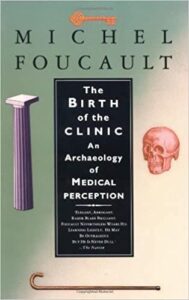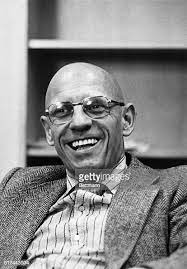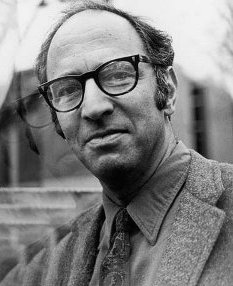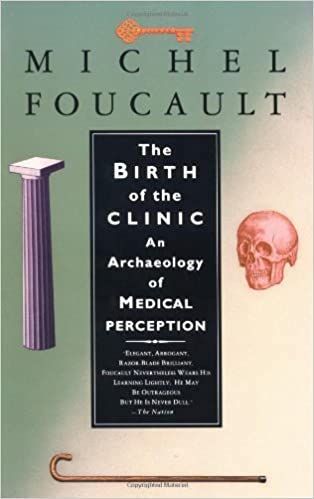
In his book The Birth of the Clinic, French philosopher Michel Foucault, who characterizes himself as an ‘archeologist of ideas’, traces the history of evolution of concepts and practices that lead on to the development of the modern medicine to the stature it is now. He dates the cardinal juncture that saw the genesis of modern medicine to the latter half of the 18th century when the concept of ‘Clinic’ (French Clinique which include both hospital and teaching institute) got established. This, Foucault demonstrates, was followed by a series of decisive change in medical ‘perception’ that finally constituted the evolution of medical epistemology (theory of knowledge) we regard as current.

THE ‘PRECLINICAL’ ERA
In the era preceding the establishment of the concept of ‘Clinic’, it was widely held that diseases in general and epidemics in particular arise as a result of a ‘breakdown’ in the balance that exist between the body and its geographic surroundings.
‘Diagnosis’, so as to say, was more of a geographic description than a clinico-pathological entity. Medical literature was essentially a chronology of events through a span of time and space than the description of discrete entities uncharacterized by spatial and temporal considerations. For instance, a medical record in early 18th century goes as:
In Marseilles in 1721 there occurred during summer an epidemic among the children of the nature of a bilious catarrh and putrid fever complicated by miliaria and ardent bilious fever during the autumn. The constitution degenerated into putrid biliousness towards the end of the season and during the winter of 1769 and 1770.
The essential basis of disease was an interaction of a set of temporal and geographic factors. Thus, it was ‘the fresh, sharp, subtle, penetrating air of Nimes in winter’ or ‘the sticky, thick, putrid air of Paris’ during summer.
The pattern of disease was thought to be due to the pattern of interaction of the time and the place over the person who is exposed to it. It was believed that ‘dryness or humidity’, ‘heat or cold’ when prolonged ensures “domination of one of our constitutional principle viz.: alkali, salt or phlegm”. Thus, a person with jaundice has an excess of ‘yellow bile’, while a person with productive cough an excess of ‘phlegm’.
In such a circumstance, the idea of an institutionalized abode for patients was something which was mostly frowned down. The best way to ‘treat’ him was to put him in the same natural environment as when he contracted the disease- so that the ‘constitutional breakdown’ itself get equilibrated. Hospitals, it was believed, would create an unnatural environment which will cause pooling of pathologies and thus the perpetuation of the illness.
THE PRECLINICAL PARADIGM
The central feature of these concepts of disease is that they are all purely descriptive ‘explanation’. They just go on to explain things just as they what they seem, without caring to develop a rational justification for the causal associations. It seems that of the umpteen explanations and interpretations one finds about a situation, few interpretations just gets prominence over others, and thereafter dominate the scene as if they are all self-evident truths. This is similar to Aristotelian physics, which thought the earth as the center of the Universe in a static position, a belief that was maintained in the Western scholastic traditions for centuries, until it was shaken down by Nicolaus Copernicus, Johannes Kepler and Galileo Galilei. The transformation of geostatic-geocentric Aristotelian views to the heliocentric geostatic view took about 50-100 years, and completely transformed the way science is practiced. Indeed, Western Science has its origin in this transformation- where observations, experimentation and modeling of unseen concepts by constant comparison and recalibration of the observed and experimental findings became the mainstay. Galileo Galilei first introduced mathematics to the study of mechanics. (see the entry titled In the Cradle of European Renaissance in this blog for a detailed background description of the Galilean scientific revolution). The Galilean application of mathematics to the study of moving objects and heavenly bodies was later developed into remarkable sophistication by Isaac Newton. Post-Newton practice and teaching of physics had not resemblance to the kind of studies on nature conducted by medieval scholars using Aristotle’s ‘arm-chair’ theories. The way scientific findings were communicated also underwent a remarkable change. ( See Leviathan and the Air-Pump: Hobbes, Boyle, and the Experimental Life by Steven Shapin and Simon Schaffer)
The ‘preclinical paradigm’ subscribes to a pattern of thought in which the tendency was more to ‘interpret’ than to observe and systemize the products of the observations. This is indeed comparable only to that of myths in theology. Indeed the Scholasticism prevalent in the European Universities of the medieval period was essentially a marriage between cherry-picked Aristotelian philosophy and Biblical mythology (see In the Cradle of European Renaissance)
When such a pattern of thought becomes so organized as to form the thought pattern of the time, we call it a paradigm. The term paradigm was coined into regular usage by the Austrian-US historian of science Thomas Kuhn to elucidate his idea that even scientific thoughts are not necessarily wholly objective as widely believed, but are greatly influenced by the predominant historical and cultural tendencies of the times.1,2 The ‘mechanism’ of a paradigm, in Kuhn’s view, is the result of certain fundamental assumptions, which are rather uncritically taken by the scientific community at some point of time so much so that they adversely influence the manner in which a community (scientific or otherwise) thinks over a temporal span.

One area where Renaissance did not show up any direct impact was medicine. Not only that, the over-enthusiastic political consciousness that followed the European Enlightenment movement was inadvertently effecting the progression of medicine. While in the field of epidemiology, the overindulgent dogmas of the ‘politics of diseases’ was ruling the show, the province of medical research in morbid anatomy was overshadowed by the paradigm that described the success stories of other scientific disciplines as physics.
The pre-18th century attempts to decipher the functional code of diseases were greatly distorted by a tendency to adapt the familiar quantitative representations of physics to the study of pathoanatomy. For instance, Foucault recounts J.F. Meckel, who in 1764 set out to study the alterations brought about in the brain by certain diseases (apoplexy, mania, phthisis) by “weighing equal volume and comparing them to determine which port of the brain has been dehydrated, which part hasbeen swollen etc–”
Another worker. Pomme, treated and cured a hysteric by bath, ten or twelve hours a day, for ten whole months. At the end of the treatment, he noticed membrane likes pieces of damp parchment peel away and pass in urine. So also, he ‘observed’, intestines peel of their internal tunics just as did the oesophagus, ureter, trachea and the tongue—-rejected as it could be by vomiting or by expectoration.
THE PARADIGM SHIFT
The story was thoroughly rewritten within barely a 100 years. Thus we see ALJ Boyle describing the false membrane in a case of syphilitic meningitis as:
False membranes are often transparent, especially when they are very thin; but usually they are white, grey or black. The thickness vary greatly; sometimes they are so tenuous that they might be compared to a spiders web— The organisation of the false membrane also display a great many differences: the thin ones are buffy, like the albuminous skins of eggs. Others often display traces of blood vessels crossing over one another in different directions—
Boyle’s departure from Pomme and Meckel is very much in evidence. The 19th century medical literature appears to have struck across a soft of imagery in some visual space. In Foucault’s words there emerges a “qualitative precision”, while Pomme “lacking any perceptual basis, speaks in the language of fantasy”. Foucault directs this dramatic change in the means by which medical events are perceived to two causes:
- the emergence of the concept of Clinic
- “the opening up of a few corpses” (facilitated, in turn, by the new found ethos of Renaissance and Enlightenment).
‘Clinic’ in which the patient comes directly under the observation of the physician slowly but steadily evoked an entirely different style of thinking in medical parlance. To the observant physician, the seat of the disease soon became the patient and nothing else. His observing eyes, unlike the chimeras of his predecessors’ theories, revealed disease as discrete identifiable clinical patterns.
Study of autopsy specimens traced the clinical patterns of diseases into discrete patterns of morbid anatomy. The seat of the disease recognized as the corpus of the patient, was soon traced to his organs, his tissues, and finally, in the 20thcentury, to his cells and the molecules that constituted them. A new paradigm of medical epistemology thus evolved.
THE SPIRIT OF PARADIGM SHIFT
Such U-turns in the thinking patterns are one of the recurring themes in the history of western civilization ( see Constantine’s Switch, The Great Resetting in this blog). The situation is in sharp contrast to a much of the Oriental civilizations, in particular that of the Indian subcontinent. Here the order is a nerve of unconditional docility, unthinking traditionalism and ritualistic conformity, all in all vacating every divergent tendency to the brute of the mediocre majority. We find ritualistic conformation and the non-questioning of the ‘reveled word’ in much of the theological streams from Satpada Brahmana and later Uttara Mimamsa treatises. These are quite similar to Scholasticism practiced in medieval Europe). The picture emerges strikingly clear if we superimpose the exposition of Foucault with that of the situation as it is in India.
THE INDIAN TRADITION
Up to the 17th century, the difference between the Indian system of Medicine and the Western system was more-or-less a matter of sheer nomenclature. Substantively and methodologically there were no major differences between the two: while Ayurveda talked of the malady of trio (the Tridosha Sidantha), the West talked about the interplay of the humors: while the formed talked of a penta-elemental ‘constitution’ (the Panchabhootha), the latter talked of a trinity (alkali, acid and phlegm). In fact, a comparative history of the Indian and Western system of medicine until the 17th century will make the list exhaustive more by their similarities than by their differences.
But somewhere around the 18th century we see this comparison coming to an abrupt end. Semantically and syntactically a new system of medicine was born in the West.
Just as Foucault traces the single most important real-time event central to the development of modern medicine, we could trace the single most important occasion that facilitated this change to the value patterns of Renaissance and Enlightenment.
If we attempt a comparison, nothing of the sort of Renaissance happened in India. In fact, there was nothing to ‘reinvent’ for renaissance to happen. Almost all streams of Indian thought are immersed in a rigorous mass of ‘absolutist’ positions. There was hardly any description of an approach free from all ‘fixed’ notions. All Indian philosophies started from the quicksand of some unquestionable first principles that could barely get out of the overbearing tenacity of these absolutist stances. The epistemology of Carvaka/Lokyata system was quite advanced in this area. However, the system was completely expunged from the dominant stream of thoughts that we do not have of the original texts of Carvaka/Lokyate school of thinking currently available. Whatever reference to the Carvaka tradition comes from the compositions of its critics.3 Nevertheless a sort of ‘censured’ reasoning techniques of Carvakas were used by other schools of thought to advance their scholastic arguments. ( I shall discuss this in a larger article on the first principles of Indian traditional schools of thoughts). Such absolutist stances are never congenial for the growth of scientific inquiry for science is essentially an exploration of a “sense of horizon”, whose facts are only contemporary, approximations of ‘truth’, and never the certainty of the absolute.
Rhetoric cleaved, Foucault makes us see Ayurveda and the whole lot of Indian medicine just as a juvenile form of the occidental medicine, retarded in its growth-mentally and physically-somewhere in the 17th century.
Here it is important to differentiate theories, hypotheses ( see What is the Principle of Falscification?) , pseudoscientific claims and protoscientific postions from each other. While a body of protoscience has the potential to evolve into standard modern medical practice when it cleaves its non-falsifiable claims and adapts standard scientific procedures to pursue relevant questions, a body of pseudoscience that questions the very fundamental principles of accepted knowledge cannot have any future ahead. The Indian mainstream administrative position is to lump protoscience with pseudoscience and advocate them as one identical category of practices. This cause huge loss of focus in handholding protoscience strands to mainstream modern medical practice. Here, ideological and political positions are barriers for enabling sound reasoning to prevail.
Micheal Foucalt’s The Birth of Clinic is a relevant read for those who are interested in the evolution of the conceptual jumps that led to the modern medical practices. It is a useful reference point for comparing the evolution of various traditional systems of medicine.
References
1. Kuhn TS. The Structure of Scientific Revolutions. University Of Chicago Press; 1970.
2. Godfrey-Smith P. Theory and Reality : An Introduction to the Philosophy of Science. Chicago Univ. Of Chicago Press; 2003.
3. Bhattacharya R. Svabhāvavāda and the Cārvāka/Lokāyata: A Historical Overview. Journal of Indian Philosophy. 2012;40(6):593-614.
Hits: 613

